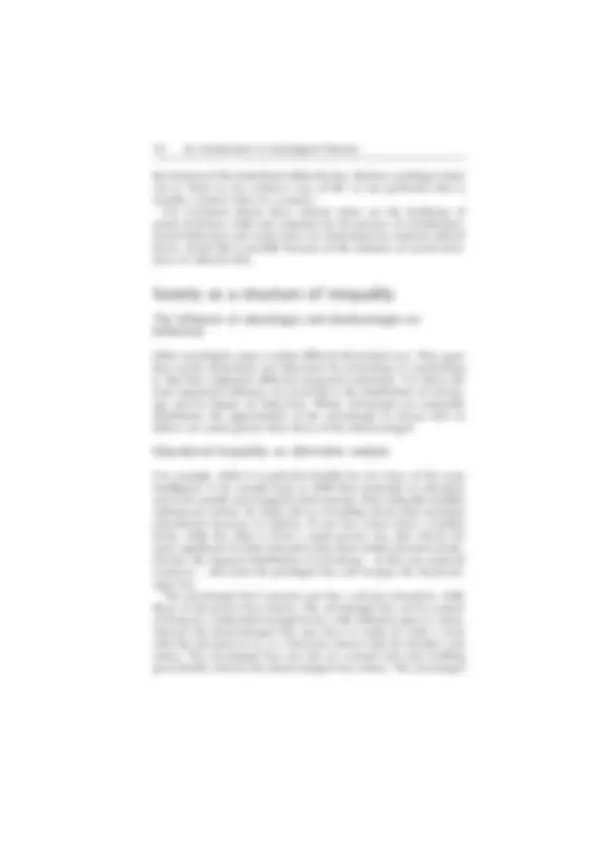
























Study with the several resources on Docsity

Earn points by helping other students or get them with a premium plan


Prepare for your exams
Study with the several resources on Docsity

Earn points to download
Earn points by helping other students or get them with a premium plan
Community
Ask the community for help and clear up your study doubts
Discover the best universities in your country according to Docsity users
Free resources
Download our free guides on studying techniques, anxiety management strategies, and thesis advice from Docsity tutors
An introduction to sociological theories, focusing on consensus and conflict perspectives. Consensus theory explains social order as a result of learned behavior and cultural agreement, while conflict theory emphasizes the unequal distribution of advantages and the role of power in shaping behavior. Both theories highlight the impact of social structures on human behavior.
Typology: Study notes
1 / 30

This page cannot be seen from the preview
Don't miss anything!























Humans are social beings. Whether we like it or not, nearly every- thing we do in our lives takes place in the company of others. Few of our activities are truly solitary and scarce are the times when we are really alone. Thus the study of how we are able to interact with one another, and what happens when we do, would seem to be one of the most fundamental concerns of anyone interested in human life. Yet strangely enough, it was not until relatively recently – from about the beginning of the nineteenth century onwards – that a specialist inter- est in this intrinsically social aspect of human existence was treated with any seriousness. Before that time, and even since, other kinds of interests have dominated the analysis of human life. Two of the most resilient, non-social approaches to human behaviour have been ‘naturalistic’ and ‘individualistic’ explanations. Rather than seeing social behaviour as the product of interaction, these theories have concentrated on the presumed qualities inherent in individuals. On the one hand, naturalistic explanations suppose that all human behaviour – social interaction included – is a product of the inherited dispositions we possess as animals. We are, like animals, biologically programmed by nature. On the other hand, individualistic explanations baulk at such grand generalizations about the inevit- ability of behaviour. From this point of view we are all ‘individual’ and ‘different’. Explanations of human behaviour must therefore always rest ultimately on the particular and unique psychological qualities of individuals. Sociological theories are in direct contrast to these
‘non-social’ approaches. Looking a little closer at them, and discovering what is wrong or incomplete about them, makes it easier to understand why sociological theories exist.
Naturalistic explanations of human activity are common enough. For example, in our society it is often argued that it is only natural for a man and a woman to fall in love, get married and have children. It is equally natural for this nuclear family to live as a unit on their own, with the husband going out to work to earn resources for his dependants, while his wife, at least for the early years of her children’s lives, devotes herself to looking after them – to being a mother. As they grow up and acquire more independence, it is still only ‘natural’ for the children to live at home with their parents, who are respons- ible for them, at least until their late teens. By then it is only natural for them to want to ‘leave the nest’, to start to ‘make their own way in the world’ and, in particular, to look for marriage partners. Thus they, too, can start families of their own. The corollary of these ‘natural’ practices is that it is somehow un- natural not to want to get married, or to marry for reasons other than love. It is equally unnatural for a couple not to want to have children, or for wives not to want to be mothers, or for mothers not to want to devote the whole of their lives to child-rearing. Though it is not right or natural for children to leave home much younger than eighteen, it is certainly not natural for them not to want to leave home at all in order to start a family of their own. However, these ‘unnatural’ desires and practices are common enough in our society. There are plenty of people who prefer to stay single, or ‘marry with an eye on the main chance’. There are plenty of women who do not like the idea of motherhood, and there is certainly any number of women who do not want to spend their lives solely being wives and mothers. There are plenty of children who want to leave home long before they are eighteen while there are many who are quite happy to stay as mem- bers of their parents’ households until long after that age. Why is this? If human behaviour is, in fact, the product of a dis- position inherent in the nature of the human being then why are such deviations from what is ‘natural’ so common? We can hardly put down the widespread existence of such ‘unnatural’ patterns of beha- viour to some kind of large-scale, faulty genetic programming. In any case, why are there so many variations from these notions of ‘normal’ family practices in other kinds of human societies? Both
example, success or failure in education is often assumed to be merely a reflection of intelligence: bright children succeed and dim children fail. Criminals are often taken to be people with certain kinds of personality: they are usually seen as morally deficient individuals, lack- ing any real sense of right or wrong. Unemployed people are equally often condemned as ‘work-shy’, ‘lazy’ or ‘scroungers’ – inadequates who would rather ‘get something for nothing’ than work for it. Suicide is seen as the act of an unstable person – an act undertaken when, as coroners put it, ‘the balance of the mind was disturbed’. This kind of explanation is attractive for many people and has proved particularly resilient to sociological critique. But a closer look shows it to be seriously flawed. If educational achievement is simply a reflection of intelligence then why do children from manual workers’ homes do so badly compared with children from middle-class homes? It is clearly nonsensical to suggest that doing one kind of job rather than another is likely to determine the intelligence of your child. Achievement in education must in some way be influenced by the characteristics of a child’s background. Equally, the fact that the majority of people convicted of a crime come from certain social categories must cast serious doubt on the ‘deficient personality’ theory. The conviction rate is highest for young males, especially blacks, who come from manual, working-class or unemployed backgrounds. Can we seriously believe that criminal personalities are likely to be concentrated in such social categories? As in the case of educational achievement, it is clear that the con- viction of criminals must somehow be influenced by social factors. Again, is it likely that the million or so people presently unem- ployed are typically uninterested in working when the vast majority of them have been forced out of their jobs, either by ‘downsizing’ or by the failure of the companies they worked for – as a result of social forces quite outside their control? Suicide would seem to have the strongest case for being explained as a purely psychological act. But if it is simply a question of ‘an unsound mind’, then why does the rate of suicide vary between societies? Why does it vary between different groups within the same society? Also, why do the rates within groups and societies remain remarkably constant over time? As in other examples, social factors must be exerting some kind of influence; explanations at the level of the personality are clearly not enough. Variations such as these demonstrate the inadequacy of theories of human behaviour which exclusively emphasize innate natural drives,
or the unique psychological make-up of individuals. If nature is at the root of behaviour, why does it vary according to social settings? If we are all different individuals acting according to the dictates of unique psychological influences, why do different people in the same social circumstances behave similarly and in ways others can understand? Clearly there is a social dimension to human existence, which requires sociological theorizing to explain it. All sociological theories thus have in common an emphasis on the way human belief and action is the product of social influences. They differ as to what these influences are, and how they should be invest- igated and explained. This book is about these differences. We shall now examine three distinct kinds of theory – consensus , conflict and action theories – each of which highlights specific social sources of human behaviour. Though none of the sociologists whose work we will spend the rest of the book examining falls neatly into any one of these three categories of theory, discussing them now will produce two benefits:
Society as a structure of rules
Imagine you live in a big city. How many people do you know well? Twenty? Fifty? A hundred? Now consider how many other people you encounter each day, about whom you know nothing_._ For ex- ample, how many complete strangers do people living in London or Manchester or Birmingham come into contact with each day? On the street, in shops, on buses and trains, in cinemas or night clubs
school. Once inside the school they will display quite regular patterns of behaviour. They will all walk along corridors, up and down stairs, in and out of classrooms, through doors, and so on. They will, by and large, not attempt to dig through floors, smash through walls, or climb out of windows. Their physical movements are constrained by the school building. Since this affects all the students similarly, their behaviour inside the school will be similar – and will exhibit quite definite patterns. In consensus theory, the same is true of social life. Individuals will behave similarly in the same social settings because they are equally constrained by cultural rules. Though these social structures are not visible in the way physical structures are, those who are socialized into their rules find them comparably determining. The levels at which these cultural rules operate can vary. Some rules, like laws for instance, operate at the level of the whole society and structure the behaviour of everyone who lives in it. Others are much less general, structuring the behaviour of people in quite speci- fic social settings. For example, children in a classroom are expected to behave in an orderly and attentive fashion. In the playground much more license is given them, while away from school their beha- viour often bears little resemblance to that expected of them during school hours. Similarly, when police officers or nurses or members of the armed forces are ‘on duty’, certain cultural rules structure their behaviour very rigidly. Out of uniform and off duty these constraints do not apply, though other ones do instead – those governing their behaviour as fathers and mothers, or husbands and wives, for instance. This shows how the theory of a social structure of cultural rules operates. The rules apply not to the individuals themselves, but to the positions in the social structure they occupy. Shoppers, police officers, traffic wardens, schoolteachers or pupils are constrained by the cul- tural expectations attached to these positions, but only when they occupy them. In other circumstances, in other locations in the social structure – as fathers or mothers, squash players, football supporters, church members, and so on – other rules come into play. Sociologists call positions in a social structure roles. The rules that structure the behaviour of their occupants are called norms. There are some cultural rules that are not attached to any particular role or set of roles. Called values , these are in a sense summaries of ap- proved ways of living, and act as a base from which particular norms spring. So, for example: ‘education should be the key to success’; ‘family relationships should be the most important thing to protect’; ‘self-help should be the means to individual fulfilment’. All these are values, and they provide general principles from which norms
directing behaviour in schools and colleges, in the home and at work are derived. According to this sociological theory, socialization into norms and values produces agreement, or consensus , between people about appropriate behaviour and beliefs without which no human society can survive. This is why it is called structural-consensus theory. Through socialization, cultural rules structure behaviour, guarantee a consensus about expected behaviour, and thereby ensure social order. Clearly, in a complex society there are sometimes going to be com- peting norms and values. For example, while some people think it is wrong for mothers to go out to work, many women see motherhood at best as a real imposition and at worst as an infringement of their liberty. Children often encourage each other to misbehave at school and disapprove of their peers who refuse to do so. Teachers usually see this very much the other way round! The Tory Party Conference is annually strident in its condemnation of any speaker who criticizes the police. Some young blacks would be equally furious with any of their number who had other than a strongly belligerent attitude towards them. Consensus theorists explain such differences in behaviour and attitude in terms of the existence of alternative cultural influences, characteristic of different social settings. A good example of this emphasis is their approach to educational inequality.
Educational research demonstrates, in the most conclusive fashion, that achievement in education is strongly linked to class membership, gender and ethnic origin. There is overwhelming evidence, for ex- ample, that working-class children of similar intelligence to children from middle-class backgrounds achieve far less academically than their middle-class counterparts. To explain this, consensus theorists turn to stock concepts in their approach to social life – norms, values, socialization and culture. Start- ing from the basic assumption that behaviour and belief are caused by socialization into particular rules, their explanation of working-class underachievement in education seeks to identify:
the freedom of the individual within the law. (Indeed, anything trotted out as ‘basic to our country’s way of life’ at any particular time is usually a central value in a society.) For consensus theory then, central values are the backbone of social structures, built and sustained by the process of socialization. Social behaviour and social order are determined by external cultural forces. Social life is possible because of the existence of social struc- tures of cultural rules.
Society as a structure of inequality
Other sociologists argue a rather different theoretical case. They agree that society determines our behaviour by structuring or constraining it. But they emphasize different structural constraints. For them, the most important influence on social life is the distribution of advant- age and its impact on behaviour. Where advantages are unequally distributed, the opportunities of the advantaged to choose how to behave are much greater than those of the disadvantaged.
For example, while it is perfectly feasible for two boys of the same intelligence to be equally keen to fulfil their potential in education and to be equally encouraged by their parents, their culturally instilled enthusiasm cannot, by itself, tell us everything about their potential educational successes or failures. If one boy comes from a wealthy home, while the other is from a much poorer one, this will be far more significant for their education than their similar (learned) desire. Clearly, the unequal distribution of advantage – in this case material resources – will assist the privileged boy and hamper the disadvant- aged one. The advantaged boy’s parents can buy a private education, while those of the poorer boy cannot. The advantaged boy can be assured of living in a substantial enough house, with sufficient space to study, whereas the disadvantaged boy may have to make do with a room with the television in it, or a bedroom shared with his brothers and sisters. The advantaged boy can rely on a proper diet and resulting good health, whereas the disadvantaged boy cannot. The advantaged
boy can be guaranteed access to all the books and equipment he needs to study, whereas the disadvantaged boy cannot. Probably most importantly, the advantaged boy will be able to continue his educa- tion up to the limit of his potential unhindered. For those who are less advantaged it is often necessary to leave school and go out to work to add to the family income. This stronger impulse usually brings education to a premature end.
Structural-conflict theory
So, one primary objection some sociologists have to structural- consensus theory is that where societies are unequal, people are not only constrained by the norms and values they have learnt via socializa- tion. Such theorists argue that it has to be recognized that people are also constrained by the advantages they possess – by their position in the structures of inequality within their society. This emphasis on the effects on behaviour of an unequal distribution of advantage in a society is usually associated with structural - conflict theory. Why are such theories called conflict theories? The kinds of inequality structures in a society vary. Ethnic groups can be unequal, young and old can be unequal, men and women can be unequal, people doing different jobs can be unequal, people of different religious beliefs can be unequal, and so on. The kinds of advantages unequally possessed by such groups can vary, too. Different groups can possess unequal amounts of power, authority, prestige, or wealth, or a combination of these and other advantages. Notwithstanding the different kinds of inequality conflict theories focus on, and the different kinds of advantages they see as unequally distributed, such theories nonetheless have in common the axiom that the origin and persistence of a structure of inequality lies in the domina- tion of its disadvantaged groups by its advantaged ones. Conflict theories are so-called because for them, inherent in an unequal society is an inevitable conflict of interests between its ‘haves’ and its ‘have- nots’. As Wes Sharrock (1977) puts it:
The conflict view is... founded upon the assumption that... any society... may provide extraordinarily good lives for some but this is usually only possible because the great majority are oppressed and degraded... Differences of interest are therefore as important to society as agreements upon rules and values, and most societies are so organised that they not only provide greater benefits for some than for
for conflict theorists, far from being the means to social order via consensus, socialization is much more likely to be an instrument of power – producing social order by means of force and domination. Imagine the following scenario. It is early morning in a Latin Amer- ican country. A group of agricultural labourers, both men and women, are waiting by a roadside for a bus to arrive to drive them to work. Suddenly two vans draw up and four hooded men jump out. At gunpoint they order the labourers into the backs of the vans, which then race away deep into the surrounding countryside. At nightfall they are abandoned and the labourers transferred into a large covered lorry. This is driven through the night, deep into the mountains. Before daybreak it reaches its destination – a huge underground mine, built deep into the heart of a mountain. Here the labourers are horrified to find a vast army of slaves toiling away, under constant surveillance by brutal guards. After being given a meagre meal, the labourers are forced to join this workforce. As they live out their desperate lives within this mountain world, some of the slaves try to escape. When caught they are publicly punished as a deterrent to others. Two attempts to escape result in public execution. As the labourers get older, they rely on each other for companionship, and on their memories for comfort. They keep sane by recounting stories of their former lives. In the fullness of time, children are born to them. The parents are careful to tell these chil- dren all about their past. As the children grow up and have children of their own, they, too, are told tales of their grandparents’ land of lost content. But for them these are handed-down, historical stories, not tales based on experience. As the years go by, though the facts of life within the mountain remain the same, the perception of life in it by the participants alters. By the time five or six generations of slaves have been born, their knowledge of the world of their ancestors’ past lives has become considerably diminished. It is still talked about, some- times. But by now it is a misted world of folklore and myth. All they know from experience is slavery. So far as any of them can remember, they have always been slaves. In their world, slavery is ‘normal’. In effect, to be a slave means something very different to them from what it meant to their ancestors. A similar process occurs with the oppressors. As the slaves’ view of themselves has altered over time, so the necessity for naked force has become less and less. As, through socialization, their subordinates have begun to acquiesce in their own subordination, the guards no longer brandish guns and clubs. Because of this, they no longer see themselves as the original guards did. Both the dominant and the
subordinate, knowing nothing else, have, through socialization, come to see the inequality in their world in a very different light from the original inhabitants. Though this story is rather larger-than-life, it does allow us to see the role of socialization into cultural rules as conflict theorists see it. Their argument is that we must be careful not to dismiss the presence of conflict in societies just because a consensus seems to prevail. Naked force is only necessary so long as people see themselves as oppressed. If they can be persuaded that they are not oppressed, or if they fail to see that they are, then they can be willing architects in the design of their own subordination. The easiest way to exercise power, and gain advantage as a result, is for the dominated to be complicit in their own subordination. Conflict theorists tell us that rather than simply describe cultural rules in a society, therefore, we must carefully examine their content. We must ask: ‘Who benefits from the particular set of rules prevailing in this society, rather than some other set?’ Cultural rules cannot be neutral or all-benevolent. Of course, consensus theorists are right to say that people are socialized into pre-existing norms and values. But for conflict theorists this tells us only half the story. We must also find out whether some groups benefit more than others from the existence of a particular set of rules and have a greater say in their construction and interpretation. If they do, then the process of socialization into these is an instrument of their advantage – it is an instrument of their power.
For example, even a cursory glance at the kinds of occupations held by women and the kinds of rewards they receive for doing them clearly indicates the advantages men have over women in our society. Of course, Britain once had a female prime minister, and today has some female civil servants, MPs, judges, and university vice-chancellors as well an increasing number of women in leading positions in business. But this cannot hide the fact that there is still markedly unequal occupational opportunity, and unequal economic reward, based on gender. The facts are that males dominate the best-rewarded and most prestigious occupations and (despite the Equal Opportunities Com- mission) usually receive greater rewards when they perform the same jobs as women. Clearly, there is a considerable potential conflict of interests be- tween men and women here. It is in men’s interests for women not to
Such advertising socializes both men and women, of course. The outcome is a stereotypical view of womanhood and of the place of women in society, embraced not only by those whom it disadvant- ages, but also by those who benefit from it. There is a consensus about such things. However, it is not the kind of consensus portrayed by the consensus theorist. It is an imposed consensus, preventing the conflict that would break out if people were allowed to see the world as it really is.
There are a number of sociological theories that can be called structural-conflict theories, in that they are based on two main premises:
Structural-consensus theory and structural-conflict theory emphasize different kinds of influences on thought and behaviour. Though both theories see the origin of human social life in the structural influences or determinants of society external to the individual, they disagree about what this outside society consists of. Consensus theory is based on the primacy of the influence of culture – what we learn to want as a result of socialization. Conflict theory, in contrast, pays most atten- tion to the conflict inherent in the relationship between unequally advantaged groups in society and argues that the content of culture should be seen as a means of perpetuating relationships of inequality.
Society as the creation of its members
A third kind of sociological theory leads in a rather different direc- tion. It still attempts to explain why human beings in society behave
in the orderly ways they do. But instead of looking for the answer in the influence of a social structure which people confront and are constrained by, this theory argues something else. From this point of view, the most important influence on an individual’s behaviour is the behaviour of other individuals towards him or her. The focus is not on general cultural rules, or on the unequal distribution of advantage in whole societies. It is on the way individual social encounters work
Action theory
Action theorists stress the need to concentrate on the micro -level of social life, the way particular individuals are able to interact with one another in individual social encounters, rather than on the macro - level, the way the whole structure of society influences the behaviour of individuals. They argue that we must not think of societies as structures existing independently of, and prior to, the interaction of individuals. For action theorists, societies are the end result of human interaction, not its cause. Only by looking at how individual humans are able to interact can we come to understand how social order is created. To see how this happens, let us reflect on the kinds of action of which humans are capable. Some human action is like the action of phenomena in the inan- imate world – purpose less , or lacking intention. We all do things involuntarily – like sneezing, blinking or yawning. We do not choose to feel fear, excitement, or pain, or choose to react in certain ways to those feelings. So far as we know, the actions of non-human animate phenomena are purely instinctive (automatic or reflex responses to
takes place in the company of others. Most of the situations we have to define in order to choose how to act are social ; they involve other humans doing things. You see a very large man shaking his fist and shouting at you, and conclude that he is not overjoyed that you have driven into the back of his car. As a result you decide not to suggest that he was responsible for the accident because of the way he parked. You see a traffic warden slipping a parking ticket under your wind- screen-wiper, and decide not to contribute to the Police Benevolent Fund after all. This is social action. It is action we choose to take in the light of what we interpret the behaviour of others to mean.
There is more to social action than interpretation leading to action, however. Most of the time when we interact with other humans, they want us to arrive at certain interpretations of their actions – they want us to think one thing of them rather than another. The man whose car has just been damaged is not behaving in the rather distinctive manner described above because he wishes the culprit to come round to his house for tea. The man scratching his nose in the auction room is not (usually) alleviating an itch. He is communicating his bid to the auctioneer, and he expects that the latter will interpret his actions as he wishes. Pedestrians in London streets do not wave to taxi-drivers because they are, or want to become, their friends. They do so because they want a lift. Dress can often organize interpretation just as effectively as ges- tures, of course. Though the punk rocker, the skinhead, the bowler- hatted civil servant, the police officer and the traffic warden whom we encounter in the street make no apparent attempt to communicate with us, they are certainly doing so, nevertheless. They want us to think certain things about them when we see them, so they choose to communicate by the use of uniforms. They are making a symbolic use of dress, if you like; after all, like gestures, garments symbolize what their users want us to interpret about them. The most effective symbols humans have at their disposal are words
are able to use to interact meaningfully with one another, and thereby to create society. From this point of view, societies are made up of individuals engag- ing in a countless number of meaningful encounters. The result is social order. But this is no determined order. It is not the result of the imposition of cultural rules, as the consensus theorist sees it. Nor is it the result of the constraints of a world where advantages are unequally distributed, and where cultural rules legitimate these constraints, as the conflict theorist sees it. Instead, society is an order created, or accomplished, by the capacities of the members them- selves. It is the outcome of innumerable occasions of interaction, each one accomplished by interpreting, meaning-attributing actors who can make sense of the social settings in which they find themselves and who choose courses of action accordingly.
There is another important difference between structural and inter- pretive conceptions of society. For structural theorists, the character of a society – its social structure – is not in doubt. It is a ‘real’ thing that exists outside of its members. For the interpretivist, however, it is much more difficult to describe a society that is the outcome of interpretation as somehow ‘true’ or ‘real’ in this structural sense. For the interpretivist, being human involves interpreting what is going on around one – saying: ‘This is what is happening here’, and choosing an appropriate course of action in the light of this inter- pretation. However, such interpretations of ‘what is going on here’ can only ever be considered ‘correct’ or ‘true’ for the particular person doing the interpreting. What is ‘really’ going on depends on how the individual sees it. Reality is in the eye of the beholder. We act in ways we consider appropriate. What we consider appropriate depends upon what we think the behaviour of others means. It is therefore by no means inconceivable that other people, in exactly the same social situ- ations as ourselves, would have taken the behaviour around them to mean something very different, and would therefore have taken very different courses of action from us. For example, a car crashes into a wall on a wet winter’s even- ing. The police officer called to the scene discovers a dead driver and a strong smell of drink in the car. A search reveals an empty whisky bottle underneath a seat. Like all humans encountering a social situation, the officer engages in a process of interpretation, defining the situation. Weighing up the evidence, he or she decides